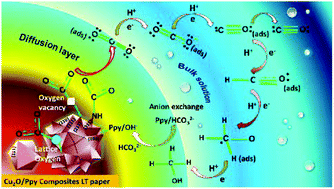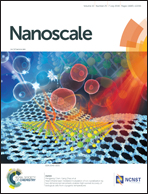Facet- and structure-dependent catalytic activity of cuprous oxide/polypyrrole particles towards the efficient reduction of carbon dioxide to methanol†
Abstract
The preparation of cost-effective, stable catalysts for the selective reduction of carbon dioxide (CO2) to C1 products such as methanol is extremely important because methanol can be used directly as a fuel or it can be converted into other value-added products. However, the catalysts currently used for the reduction of CO2 to methanol exhibit poor selectivity, poor stability and very low faradaic efficiency. Herein, we used low-cost, stable cuprous oxide/polypyrrole (Cu2O/Ppy) particles having structures of octahedra and icosahedra (microflowers) that were prepared on linen texture (LT) papers for the selective reduction of CO2 to form a value-added single C1 product, methanol. The Cu2O/Ppy particles possessing both octahedral and microflower shapes with exposed low-index (111) facets and high-index (311) and (211) facets are denoted as Cu2O(OL-MH)/Ppy particles. The as-prepared Cu2O(OL-MH)/Ppy particles exhibited high catalytic activity and selectivity towards the electrochemical reduction of CO2 at −0.85 V vs. RHE to form methanol, with a faradaic efficiency of 93 ± 1.2% and an average methanol formation rate of 1.61 ± 0.02 μmol m−2 s−1. The X-ray photoelectron spectroscopy (XPS) analysis revealed that the pyrrolic nitrogen atoms present in the Ppy shell played a dominant role as active sites for CO2 molecules. The Raman bands of Ppy and Cu2O did not shift even after being subjected to electrolysis for several hours, suggesting superior stability of the Cu2O(OL-MH)/Ppy particles. The high resolution microscopic, spectroscopic, diffraction and electrochemical analysis results clearly revealed that the Ppy shell protected the Cu2O particles and avoided corrosion, dissolution, and structural and crystal facet changes, leading to greater stability. The low-cost, durable, flexible, and catalytically active Cu2O(OL-MH)/Ppy LT paper holds great potential for catalytic, photocatalytic and energy storage applications.



 Please wait while we load your content...
Please wait while we load your content...